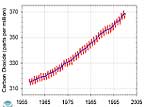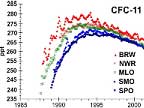World leader in monitoring atmospheric climate forcing agents
What does the Climate Monitoring and Diagnostics Laboratory do for the nation?
The Climate Monitoring and Diagnostics Laboratory (CMDL) conducts research related to atmospheric elements that are capable of forcing change in the climate of the Earth or that may deplete its ozone layer. CMDL monitors greenhouse gases, aerosols, ozone, ozone-depleting gases, and solar and terrestrial radiation at global sites including five Baseline Observatories. It differs from other NOAA labs in that it is the only lab with a primary mission of monitoring atmospheric parameters continuously over decades to centuries. The observatories at Mauna Loa, Hawaii, and at the South Pole have been in operation since 1957; the Mauna Loa CO2 (carbon dioxide) record is considered one of the most important long-term geophysical records on earth. CMDL is comprised of five research groups each tackling different, yet related, aspects of the climate-forcing issue.
Recent Accomplishments:
- Through analysis of CO2 from the 65 site CMDL Global Flask Network, CMDL has established that forests and agriculture in North America may be sequestering a sizable fraction of the carbon dioxide produced by fossil fuel combustion in the U.S. Payoffs: This finding opens possibilities that forestry and agricultural practices may be modified to reduce the rate of the global carbon dioxide increase, and especially that share attributed to the U.S.
- Through precise measurements of ozone and ultraviolet radiation in the pristine atmosphere of the Mauna Loa Observatory, CMDL established for the first time a clear, inverse correlation between ozone and ultraviolet radiation. Payoffs: This relationship verifies the role the ozone layer plays in protecting human life and safety as increased ultraviolet radiation produces cancer in humans and can have detrimental effects on plants and animals.
- Through global measurements of all the important ozone destroying chlorine-bearing molecules, CMDL established that tropospheric total chlorine peaked in the early 1990s and is now slowly decreasing. Payoffs: This indicates that stratospheric ozone depletion should begin to decrease early in this century. This bodes well for humanity and affirms that global controls on ozone depleting chemicals (Montreal Protocol), which were based on NOAA science, were the right decision.
- From measurements in the Atlantic and Pacific Oceans, CMDL demonstrated that the global oceans are major sources and sinks for atmospheric methyl bromide, an ozone-destroying compound used extensively in agriculture for fumigation. Payoffs: This raises issues as to whether agriculture is playing as large a role in the global methyl bromide budget as once thought and provides information regarding the overall strategy of rapidly phasing out agricultural use of methyl bromide.
- From continuous long-term background measurements at the Mauna Loa, Hawaii and Barrow, Alaska Observatories, as well as ozone profile measurements from the CMDL station at Trinidad Head, California, transport of dust and air pollution from Asia to North America has been well established. Payoffs: To fully understand air quality in the western U.S., these effluents from Asia will need to be monitored over the Pacific Ocean and at the west coast of the U.S. as they may become a factor in regional air quality within a decade. CMDL is expanding its global network to accomplish this task.
What’s next for CMDL?
CMDL expects the need to measure climate forcing to grow dramatically in the future for several reasons. First, the U.S. Congress and industry are taking the responsibilities of long-term climate change and its ramifications seriously. They are also aware that the North American continent, mainly the United States, can, at times, absorb a large fraction of the carbon dioxide it produces from fossil fuel emissions. Future meetings of the parties to the Framework Convention on Climate Change will continue to propose new regulations, likely including credits for carbon sequestration. The growing demand for global carbon dioxide data requires the expansion of the 65-site cooperative global flask-sampling network. In response, CMDL has begun to build an Atmospheric Carbon Cycle Observing System concentrating on the U.S. using instrumented small aircraft and tall communication towers. The NOAA Strategic Plan and the Climate Change Science Program recognize the importance of reducing the uncertainty in the U.S. terrestrial carbon sink.
In the future, the destruction of the ozone layer could become worse, with resulting elevated levels of ultraviolet radiation, unless the current production and emission of CFC and halon compounds by developing nations follows a stringent formula for reduction, and the phasing out of hydrochloro-fluorocarbon replacements for CFC's takes place by the year 2030 as prescribed by the Montreal Protocol. Therefore, continued vigilance in global monitoring of these ozone-depleting compounds and ozone itself, to detect the expected recovery, remain priorities for CMDL.
CMDL expects activities in air-quality monitoring to grow because future effluents from expanding Asian economies are projected to soon dominate global air pollution outputs. Long-range transport of high concentrations of air pollution is regularly measured at the Mauna Loa, Hawaii, and Barrow, Alaska stations. Because of ramifications for federal and state air-quality standards, of this air pollution flowing into the western United States, CMDL established a Baseline Station at Trinidad Head, California on the west coast of the U.S., and is expanding its measurement programs off the east coast of Asia. In the fall of 2003, CMDL will begin weekly airborne vertical profiles of trace gas and ozone concentrations upwind of the California coast near Trinidad Head.
Research Partnerships:
CMDL has research partnerships with federal agencies such as NASA, DOE, EPA, USGS and 16 universities in the United States and maintains cooperative greenhouse gas flask sampling and/or ozone monitoring projects in 20 states and 37 foreign countries. CMDL also has working agreements with the United Nations Environment Program and the World Meteorological Organization.
Budget and Staff
The FY 2003 enacted budget for the CMDL budget lines totaled $6.1M, and its request for FY 2004 totaled $6.9M. CMDL has 48 federal employees, 2 contractors, and 31 Joint Institute employees.




 For
more information, contact:
For
more information, contact: